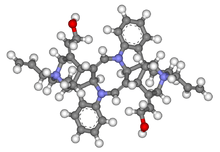Alcuronium chloride
Alcuronium chloride is a neuromuscular blocking (NMB) agent, alternatively referred to as a skeletal muscle relaxant. It is a semi-synthetic substance prepared from C-toxiferine I,[1] a bis-quaternary alkaloid obtained from Strychnos toxifera. C-toxiferine I itself has been tested for its pharmacological action and noted to be a very long acting neuromuscular blocking agent[2] For a formal definition of the durations of actions associated with NMB agents, see page for gantacurium. The replacement of both the N-methyl groups with N-allyl moieties yielded N,N-diallyl-bis-nortoxiferine, now recognized as alcuronium (and at one time marketed as the proprietary agent called Alloferin).
 | |
 | |
| Clinical data | |
|---|---|
| AHFS/Drugs.com | International Drug Names |
| ATC code | |
| Pharmacokinetic data | |
| Metabolism | not metabolized |
| Excretion | 70–90% unchanged in urine 1.3ml/kg/min t1/2 2–4 hours |
| Identifiers | |
| |
| CAS Number | |
| PubChem CID | |
| IUPHAR/BPS | |
| ChemSpider | |
| UNII | |
| ChEBI | |
| CompTox Dashboard (EPA) | |
| ECHA InfoCard | 100.035.648 |
| Chemical and physical data | |
| Formula | C44H50N4O2+2 |
| Molar mass | 666.910 g·mol−1 |
| 3D model (JSmol) | |
| |
| |
| | |
Inclusion of the allylic functions presented an enhanced potential area of biotransformation, and thus alcuronium is observed to have a much shorter duration of neuromuscular blocking action than its parent C-toxiferine I.[3] It also has a more rapid onset of action, and is ~1.5 times as potent as tubocurarine.[4] The pharmacological action of alcuronium is readily reversed by neostigmine, and it produced little histamine release.[5] The major disadvantage of alcuronium is that it elicits a vagolytic effect produced by a selective atropine-like blockade of cardiac muscarinic receptors.[4][6][7]
Effects
- Cardiovascular system: histamine release and blockage of the sympathetic ganglia including adrenal medulla could cause hypotension
- Respiratory: apnea due to phrenic blockage but bronchoconstriction can occur from the histamine release
- Central nervous system: no effect on intraoccular pressure
- Autonomic ganglion blockade can cause decrease in gut motility
Special points
- Duration of action prolonged in states of low potassium, calcium and protein, also in states of high magnesium and acidosis.
- Pharmaceutically incompatible with thiopentone
- Infusion can cause fixed dilated pupils
See also
References
- Foldes FF (1954). "The Mode of Action of Quaternary Ammonium Type Neuromuscular Blocking Agents". Br. J. Anaesth. 26 (6): 394–398. doi:10.1093/bja/26.6.394. PMID 13208908.
- Waser PG (1950). Helv. Physiol. Pharmacol. Acta. 8 (3): 342–50. PMID 14793878.CS1 maint: untitled periodical (link)
- Martin-Smith M (1971), In: Ariens EJ (ed.), "Drug Design". Vol. 2. Academic Press. New York and London. pp.453-530.
- Speight TM, Avery GS (1972). "Pancuronium Bromide: A Review of its Pharmacological Properties and Clinical Application". Drugs. 4 (3–4): 163–226. doi:10.2165/00003495-197204030-00002. PMID 4264763.
- Thompson MA (1980). Br. J. Hosp. Med. 23 (2): 153–4, 163–4, 167–8 passim. PMID 6102875.CS1 maint: untitled periodical (link)
- Coleman AJ, Downing JW, Leary WP, Moyes DG, Styles M (1972). "The immediate cardiovascular effects of pancuronium, alcuronium and tubocurarine in man". Anaesthesia. 27 (4): 415–22. doi:10.1111/j.1365-2044.1972.tb08247.x. PMID 4264060.
- Hughes R, Chapple DJ (1976). "Effects of Non-Depolarizing Neuromuscular Blocking Agents on Peripheral Autonomic Mechanisms in Cats". Br. J. Anaesth. 48 (2): 59–68. doi:10.1093/bja/48.2.59. PMID 130154.
Further reading
- Zahn K, Eckstein N, Tränkle C, Sadée W, Mohr K (2002). "Allosteric modulation of muscarinic receptor signaling: alcuronium-induced conversion of pilocarpine from an agonist into an antagonist". J Pharmacol Exp Ther. 301 (2): 720–8. doi:10.1124/jpet.301.2.720. PMID 11961078. S2CID 534003.
- Maass A, Mohr K (1996). "Opposite effects of alcuronium on agonist and on antagonist binding to muscarinic receptors". Eur J Pharmacol. 305 (1–3): 231–4. doi:10.1016/0014-2999(96)00240-3. PMID 8813558.
- Jakubík J, Tucek S (1994). "Protection by alcuronium of muscarinic receptors against chemical inactivation and location of the allosteric binding site for alcuronium". J Neurochem. 63 (5): 1932–40. doi:10.1046/j.1471-4159.1994.63051932.x. PMID 7931349.
- Proska J, Tucek S (1994). "Mechanisms of steric and cooperative actions of alcuronium on cardiac muscarinic acetylcholine receptors". Mol Pharmacol. 45 (4): 709–17. PMID 8183250.